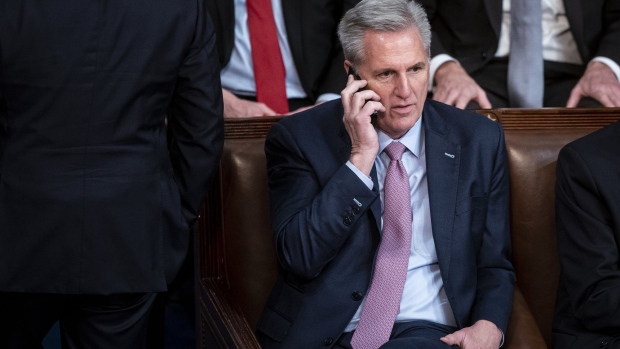Jan 6, 2023
McCarthy Deal With Rebels Would Heighten Risk of Debt Standoff
, Bloomberg News

(Bloomberg) -- House GOP leader Kevin McCarthy’s deal with ultraconservative Republicans to get their votes in the speaker election includes provisions that increase the possibility of a market-rattling showdown over the US debt ceiling later this year.
One of the main demands of the GOP faction McCarthy had to negotiate with was using the nation’s debt limit to try to force deep cuts in the federal budget. The issue will come to a head sometime after July 1 when the $31 trillion limit will need to be raised to prevent a default on debt payments.
“There will be no clean increase in the debt ceiling,” Pennsylvania Republican Scott Perry, chair of House Freedom Caucus and one of the leaders of the mutiny, said Friday.
Arkansas Representative French Hill, who helped negotiate the deal, told reporters that there is a commitment that spending cuts will be tied to any increase in the debt ceiling. That is sure to hit solid opposition in the Democratic-controlled Senate and from President Joe Biden.
Republicans want “spending reforms to be connected with any advance of the debt ceiling,” said Hill.
Even taking the country to the brink of default is risky for investors. And the prospect of a government shutdown also becomes more likely.
Hill said McCarthy also committed to fashioning a fiscal 2024 budget resolution that caps spending at 2022 levels. Whether defense or non-defense levels would be cut in that resolution would be up to the Budget Committee and the House to decide.
The informal debt ceiling commitment comes on top of changes to House rules that will empower the conservative rebels to enforce the deal. The binding changes are to be voted on by the House.
One of the most significant changes would allow just one lawmaker to call for an immediate vote of no confidence in the speaker, effectively giving McCarthy’s detractors within his own party a veto over his actions. Democrats had raised the threshold to a majority when they controlled the House.
A similar rule effectively drove former Speaker John Boehner from power in 2015, and many Republicans prefer a far higher threshold to prevent a small group of lawmakers from having outsize influence.
The proposed change would give McCarthy very little leeway to negotiate with Senate Democrats.
There is a procedure available to House Democrats to try to force a debt ceiling vote, however. They can file a discharge petition, and if that gets more than 218 signatures — which would need require getting at least five Republicans on board — a bill will be brought to the floor over the speaker’s objections.
The House is also on track to adopt other changes that are anathema to Senate Democrats and will add new complexity to reaching accord on spending bills.
One, known as the “Holman Rule,” would allow Congress to use appropriations bills to reduce the salary of or fire specific government officials. That would allow Republicans to target administration officials they oppose, such as Homeland Security Secretary Alejandro Mayorkas.
Another rule, known as “cut-go,” would require any new spending to be offset by cuts elsewhere in the budget.
Hill said that under the deal, stopgap resolutions would be sent to the Senate to ensure government stays open in the event of an impasse on spending bills.
©2023 Bloomberg L.P.






